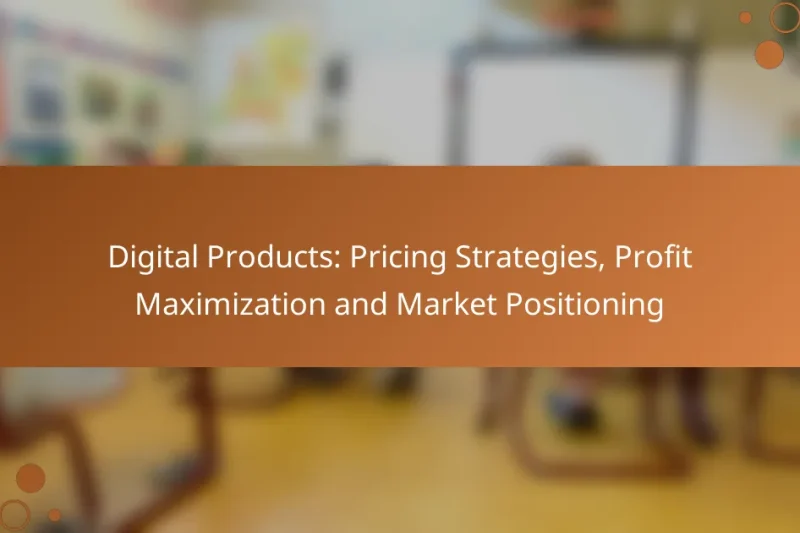Crowdfunding has emerged as a vital tool for digital product creators in the USA, offering not … Digital Products: Crowdfunding, Project Funding and Community SupportRead more
Digital Products: Monetization Strategies
Monetizing digital products effectively requires a strategic approach tailored to your audience and offerings. Popular strategies include subscription models, freemium offerings, one-time purchases, affiliate marketing, and online courses, each with distinct benefits that can enhance revenue and customer loyalty. By understanding and implementing these methods, businesses can optimize their digital product sales and foster long-term engagement.
Digital Products: Income Streams, Revenue Diversification and Customer Engagement
Digital products offer a unique opportunity for businesses to diversify their income streams through various tailored … Digital Products: Income Streams, Revenue Diversification and Customer EngagementRead more
Digital Products: Upselling, Cross-selling and Customer Value
In the realm of digital products, upselling and cross-selling are essential strategies for enhancing customer value … Digital Products: Upselling, Cross-selling and Customer ValueRead more
Digital Products: Licensing, Monetization and Content Rights
Understanding the intricacies of licensing, monetization, and content rights is essential for anyone involved in digital … Digital Products: Licensing, Monetization and Content RightsRead more
Digital Products: Freemium Models, Effectiveness and User Retention
The freemium model has become a popular strategy for digital products, allowing users to access basic … Digital Products: Freemium Models, Effectiveness and User RetentionRead more
Digital Products: Pricing Strategies, Profit Maximization and Market Positioning
In the competitive landscape of digital products, effective pricing strategies are crucial for aligning perceived value … Digital Products: Pricing Strategies, Profit Maximization and Market PositioningRead more
What are the best monetization strategies for digital products?
The best monetization strategies for digital products include subscription models, freemium offerings, one-time purchases, affiliate marketing, and online courses. Each strategy has unique advantages and considerations that can significantly impact revenue generation and customer engagement.
Subscription models
Subscription models involve charging customers a recurring fee for access to a product or service. This approach provides predictable revenue and fosters long-term customer relationships. Common examples include streaming services and software as a service (SaaS) platforms.
When implementing a subscription model, consider offering different tiers to cater to various customer needs. Monthly or annual billing options can also enhance flexibility and customer retention.
Freemium offerings
Freemium offerings allow users to access a basic version of a product for free while offering premium features at a cost. This strategy can attract a large user base quickly, as the initial barrier to entry is low. Popular apps often use this model to convert free users into paying customers.
To maximize the effectiveness of freemium offerings, ensure that the free version provides enough value to entice users while highlighting the benefits of upgrading. Monitor conversion rates to assess the success of this strategy.
One-time purchases
One-time purchases involve selling a digital product for a single payment, such as eBooks, software licenses, or downloadable content. This straightforward approach can be appealing to customers who prefer not to commit to ongoing payments.
To optimize one-time purchases, focus on creating high-quality products that meet specific customer needs. Consider offering limited-time discounts or bundles to encourage immediate sales.
Affiliate marketing
Affiliate marketing involves promoting other companies’ products and earning a commission for each sale made through your referral. This strategy can be effective for bloggers, influencers, and content creators looking to monetize their audience without creating their own products.
To succeed in affiliate marketing, choose products that align with your brand and resonate with your audience. Transparency about affiliate relationships can build trust and encourage more conversions.
Online courses
Online courses are a popular way to monetize expertise by teaching skills or knowledge through digital platforms. This strategy can generate significant income, especially if the content addresses a high-demand topic.
When creating online courses, focus on delivering value through engaging content and practical applications. Consider using platforms like Udemy or Teachable to reach a wider audience and streamline the sales process.
How can I implement subscription models for digital products?
Implementing subscription models for digital products involves offering customers recurring access to your content or services for a set fee. This approach can enhance customer retention and provide a steady revenue stream.
Monthly payment plans
Monthly payment plans allow customers to pay a fixed amount each month for access to your digital product. This model is appealing for users who prefer lower upfront costs and flexibility. Consider offering a free trial period to attract new subscribers.
When setting prices, aim for a range that reflects the value of your product while remaining competitive. For instance, many software subscriptions range from $5 to $50 per month, depending on features and market demand.
Annual subscriptions
Annual subscriptions require customers to pay for a full year upfront, often at a discounted rate compared to monthly payments. This model can improve cash flow and reduce churn rates, as customers are committed for a longer period.
To incentivize annual subscriptions, consider offering a discount of 10-20% compared to the total cost of monthly payments. This can make the annual option more attractive to potential subscribers.
Tiered pricing structures
Tiered pricing structures offer multiple subscription levels, each with different features and pricing. This approach allows you to cater to various customer segments, from casual users to power users willing to pay more for advanced features.
For example, you might offer a basic plan at $10 per month, a standard plan at $20, and a premium plan at $30, with each tier providing additional benefits. Ensure that the value proposition for each tier is clear to help customers choose the right option for their needs.
What are the benefits of freemium offerings?
Freemium offerings provide a way to attract users by allowing them to access basic features at no cost, while premium features are available for a fee. This model can enhance user engagement and create a pathway for monetization as users become familiar with the product.
User acquisition
Freemium models are effective for user acquisition because they lower the barrier to entry. Users can try the product without any financial commitment, which can lead to a larger initial user base. For example, a mobile app offering a free version can attract thousands of downloads, significantly increasing visibility and potential customer conversion.
Upselling opportunities
Once users are engaged with the free version, there are numerous upselling opportunities to convert them into paying customers. By showcasing the added value of premium features, such as advanced functionalities or ad-free experiences, businesses can encourage users to upgrade. A common strategy is to offer limited-time promotions or exclusive content to incentivize upgrades.
Market testing
Freemium offerings allow companies to test market demand and user preferences without significant upfront investment. By analyzing user behavior and feedback on the free version, businesses can refine their premium offerings. This approach helps in identifying which features are most appealing, allowing for data-driven decisions on product development and marketing strategies.
How do I price one-time purchases effectively?
To price one-time purchases effectively, consider factors such as production costs, perceived value, and market competition. A well-thought-out pricing strategy can enhance sales while ensuring profitability.
Cost-based pricing
Cost-based pricing involves setting a price based on the total costs of production plus a markup for profit. This method ensures that all expenses are covered, making it a straightforward approach. For digital products, consider costs like development, marketing, and distribution.
When using cost-based pricing, calculate your total costs and add a reasonable profit margin, typically ranging from 20% to 50%. For example, if your total cost is $30, a price of $45 to $60 could be appropriate.
Value-based pricing
Value-based pricing focuses on the perceived value of the product to the customer rather than the cost of production. This strategy can lead to higher profits if customers believe the product offers significant benefits. Understanding your target audience’s needs and preferences is crucial.
To implement value-based pricing, conduct surveys or gather feedback to assess how much customers are willing to pay. For instance, if your digital product saves users time or enhances their productivity, you might price it higher based on that perceived value.
Competitive analysis
Competitive analysis involves examining the pricing strategies of similar products in the market. This approach helps you position your product effectively and avoid pricing yourself out of the market. Look at both direct competitors and substitutes to get a comprehensive view.
To conduct a competitive analysis, identify key competitors and analyze their pricing structures. Consider factors like features, quality, and customer reviews. This information can guide you in setting a competitive price that attracts customers while maintaining profitability.
What role does affiliate marketing play in digital product monetization?
Affiliate marketing is a crucial strategy for monetizing digital products, allowing creators to earn commissions by promoting third-party products. This approach leverages partnerships to expand reach and generate revenue without the need to develop additional products.
Commission-based earnings
Commission-based earnings from affiliate marketing can vary widely, typically ranging from 5% to 50% of the sale price, depending on the product and the affiliate program. For digital products, such as e-books or online courses, higher commission rates are common due to lower overhead costs. This model incentivizes affiliates to drive sales effectively.
To maximize earnings, choose affiliate programs that align well with your audience’s interests. Track performance metrics to identify which products yield the highest returns and adjust your strategies accordingly.
Partnership opportunities
Affiliate marketing opens up various partnership opportunities with brands and other content creators. Collaborating with established companies can enhance credibility and provide access to a broader audience. Look for programs that offer exclusive deals or promotions to make your offerings more attractive.
Consider reaching out to niche influencers who share your target market. Joint promotions or bundled offerings can create win-win scenarios, benefiting both parties through shared audiences and increased sales.
Brand exposure
Engaging in affiliate marketing can significantly boost brand exposure. By promoting products through various channels, such as blogs, social media, or email newsletters, you can reach potential customers who may not be aware of your brand. This increased visibility can lead to higher traffic and conversions.
To enhance brand exposure, create high-quality content that naturally incorporates affiliate links. Focus on providing value to your audience while subtly promoting products, ensuring that your recommendations resonate with their needs and preferences.
How can online courses enhance digital product revenue?
Online courses can significantly boost digital product revenue by providing valuable educational content that attracts and retains customers. They create additional income streams while enhancing the perceived value of existing products.
Creating a Diverse Course Catalog
Offering a variety of online courses can cater to different audience segments and learning preferences. Consider developing courses that range from beginner to advanced levels, covering various topics related to your digital products.
For example, if you sell software, you might create courses on basic usage, advanced features, and industry best practices. This diversity can increase customer engagement and lead to higher sales.
Bundling Courses with Products
Bundling online courses with your digital products can enhance their appeal and justify higher price points. Customers often appreciate added value, and this strategy can lead to increased conversion rates.
For instance, if you offer a graphic design tool, consider including a course on design principles as part of the purchase. This not only boosts sales but also helps customers use your product more effectively.
Implementing Subscription Models
Subscription models for online courses can provide a steady revenue stream. By charging a monthly or yearly fee, you can offer continuous access to new content, updates, and community support.
This model encourages customer loyalty and can lead to predictable income. Consider platforms that allow for easy subscription management and content delivery to streamline this process.
Leveraging Marketing Strategies
Effective marketing strategies are crucial for promoting your online courses. Utilize email marketing, social media campaigns, and partnerships with influencers to reach a broader audience.
Creating engaging content that highlights the benefits of your courses can attract potential customers. Consider offering free webinars or trial lessons to showcase the value of your courses and encourage sign-ups.





